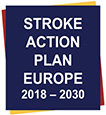Management of Acute Stroke

Every stroke patient has the right to receive the best care
The benefit of recanalisation therapies in patients with acute ischaemic stroke is strongly time-dependent, with earlier intervention achieving better outcomes.1 Stroke care systems should therefore minimise the time to assessment and initiation of treatment, before brain injury becomes irreversible.2,3
Stroke units, staffed with a stroke specialist multi-disciplinary team, are the single most effective intervention in delivering improved outcomes. And some interventions that have been shown to improve outcomes, such as thrombolysis, can only be delivered where there is well organised stroke care and high quality acute stroke units. This is also true of newer procedures such as thrombectomy.

SAP-E Key Performance Indicators
Access to stroke unit care for patients with acute stroke (% admitted to stroke unit care <24 hours).
Recanalisation treatment rate provided for patients with ischaemic stroke
(% receiving intravenous thrombolysis or mechanical thrombectomy calculated out of all ischaemic stroke admissions).
Access to: CT/MRI, vascular imaging, ECG, long-term ECG-monitoring, cardiac echo (TTE, TOE), dysphagia screening, and blood tests during stroke unit admission (% of stroke units with access).
Further research and development priorities
- How can disparities in access to stroke unit care across European countries be diminished?
- Which reperfusion options should be used, based on patient-, service- and cost-specific factors?
- How can the speed, safety and effectiveness of reperfusion approaches (drugs or devices) be optimized in Europe?
- Which pharmacological or other strategies will reduce the extent of irreversible brain damage in ischaemic stroke patients before recanalisation therapies are started?
- Which strategies will improve outcomes in ischaemic stroke patients who are not eligible for reperfusion therapies, or who do not recover after recanalisation?
- Which treatment strategies will improve outcomes in patients with ICH: haemostatic and surgical approaches, prevention of secondary injury, or intensive and tailored blood pressure management?
- Which treatment strategies will further improve outcomes in patients with SAH by reducing brain injury?
References
1 Lees KR, Bluhmki E, von Kummer R, et al. Time to treatment with intravenous alteplase and outcome in stroke: an updated pooled analysis of ECASS, ATLANTIS, NINDS, and EPITHET trials. Lancet 2010; 375: 1695–1703.
2 Emberson J, Lees KR, Lyden P, et al. Effect of treatment delay, age, and stroke severity on the effects of intravenous thrombolysis with alteplase for acute ischaemic stroke: a meta-analysis of individual patient data from randomised trials. Lancet 2014; 384: 1929–1935.
3 Saver JL, Goyal M, van der Lugt A, et al. Time to treatment with endovascular thrombectomy and outcomes from ischemic stroke: a meta-analysis. JAMA 2016; 316: 1279–1288.



